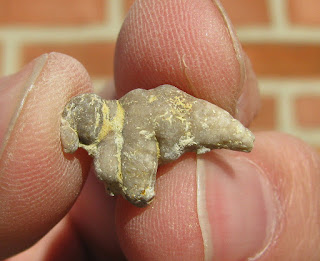This is a piece I kept as a curiosity. It appears to be the mold from some sort of epitheca that belongs to a coral (like Favosites conicus) or Bryozoan (like Lichenalia sp.). There is some sort of discolored trace on part of it which could represent a worm tube that may have been pyritized during fossilization. The question is, was it formed under the base in the sediment or on top of the base after it had flipped over?
Leon Thiesen told me a story about a dealer who used to collect lots of these and then pass them off as "Jellyfish". Leon himself was convinced until one day he found one of them after a bryozoan colony popped off the matrix. When he told the dealer about this their response was that they sold better as "Jellyfish" than bryozoan or coral impressions. It goes to show that you need to pay attention to what you are buying and not always take the word of the seller.
Next is this strange fossil that Leon gave me and told me was somewhat rare. He thinks it may be a bryozoan of some sort but he always finds them as flat, six lobed features in the rock. I think my specimen is missing a lobe.
Here are two single valves from a Rhipdomelloides oblata that I found and photographed after I had written up the blog post which featured articulated specimens. These show the interior details of each valve. I think they are from two separate individuals though.
And finally we have this odd crinoid holdfast that are often called "Chicken Feet" by the local collectors. This specimen is "curled up" but I saw other specimens in the field (on large rocks I could not bring back with me) that really did appear to resemble bird feet.
Whew! That was a long series of blog posts for a single locality. The Bois D'Arc formation is profusely fossiliferous and has a very wide variety of preserved animals. I'm pretty sure I found all the common species and a number of the lesser common ones too. While I didn't find many of the showy trilobites, I made out pretty well for surface collecting. I'm itching to go back again and trying to figure out how to fit in another visit between my other vacations.
I found the specimens shown on this page in the Bois d'Arc formation (Cravatt member) near Clarita, OK which is Devonian in age (Lockhovian stage). The Bois d'Arc and Haragan formations interfinger with each other and are roughly the same age (Devonian, Lockhovian stage). They are both roughly correlative to the Helderberg fauna of New York and thus are contemporaneous with the Coyemans, Kalkberg and New Scotland formations.













No comments:
Post a Comment